Uses
Doxorubicin is an anthracycline type of chemotherapy that is used to treat several different types of cancer. Doxorubicin works by slowing or stopping the growth of cancer cells.
How to use Doxorubicin HCL Vial
Read the Patient Information Leaflet if available from your pharmacist before you start receiving doxorubicin and each time you get an infusion. If you have any questions, ask your doctor or pharmacist.
This medication is given by injection into a vein by a health care professional. The dosage is based on your medical condition, body size, and response to treatment.
If this medication touches your skin, immediately and completely wash the skin with soap and water. If this medication gets in your eye, open the eyelids and flush with plenty of water for 15 minutes. Get medical help right away.
Caregivers should take precautions (such as wear gloves) to prevent contact with the patient's urine or other body fluid for at least 5 days after treatment. Consult your pharmacist.
Unless your doctor instructs you otherwise, drink plenty of cool fluids during treatment with this medication. This helps move the drug quickly through your body and helps reduce some of the side effects.
Side Effects
See also Warning section.
Nausea, vomiting, diarrhea, and loss of appetite may occur. Nausea and vomiting can be severe. In some cases, drug therapy may be needed to prevent or relieve nausea and vomiting. Not eating before your treatment may help relieve vomiting. Changes in diet and lifestyle, such as eating several small meals and limiting activity, may help lessen some of these effects. If any of these effects last or get worse, tell your doctor or pharmacist promptly.
Doxorubicin may give a reddish color to your urine, tears, and sweat. This effect may start in the first hours after treatment and may last up to several days. This is a normal effect of the drug and should not be mistaken for blood in your urine.
Temporary hair loss may occur. Normal hair growth should return after treatment has ended.
Nail changes (including fungal infections in the nail beds) may rarely occur.
Remember that this medication has been prescribed because your doctor has judged that the benefit to you is greater than the risk of side effects. Many people using this medication do not have serious side effects.
Tell your doctor right away if you have any serious side effects, including: diarrhea that doesn't stop, symptoms of heart failure (such as shortness of breath, swelling ankles/feet, unusual tiredness, unusual/sudden weight gain), redness/flushing of face, eye redness/itching, cough/hoarseness, joint pain, pain in the lower back/side/stomach/abdomen, painful/difficult urination, stopped/missed menstrual periods, black/tarry stools, bloody mucus or discharge in stools, fast/irregular heartbeat, dizziness, decreased urination.
Painful sores on the lips, mouth and throat may occur. To decrease the risk, limit hot foods and drinks, brush your teeth carefully, avoid using mouthwash that contains alcohol, and rinse your mouth often with cool water.
Get medical help right away if you have any very serious side effects, including: chest pain.
Within days to weeks after doxorubicin treatment, a serious skin reaction that looks likes a severe sunburn (radiation recall) may develop on any area of skin that has been previously treated with radiation. Also, doxorubicin may make you more sensitive to the sun. Limit your time in the sun. Avoid tanning booths and sunlamps. Use sunscreen and wear protective clothing when outdoors. Tell your doctor right away if you have skin redness, pain, tenderness, swelling, peeling, blisters, or if you get sunburned. Your doctor may prescribe medication to help your skin heal faster and reduce the swelling.
In children, radiation recall may occur in the lungs. Tell the doctor right away if you notice wheezing or trouble breathing in the child.
A very serious allergic reaction to this drug is rare. However, get medical help right away if you notice any symptoms of a serious allergic reaction, including: rash, itching/swelling (especially of the face/tongue/throat), severe dizziness, trouble breathing.
This is not a complete list of possible side effects. If you notice other effects not listed above, contact your doctor or pharmacist.
In the US -
Call your doctor for medical advice about side effects. You may report side effects to FDA at 1-800-FDA-1088 or at www.fda.gov/medwatch.
In Canada - Call your doctor for medical advice about side effects. You may report side effects to Health Canada at 1-866-234-2345.
Warnings
This medication must be given slowly into a vein only. It is very important not to inject this medication into a muscle or beneath the skin. If this medication accidentally leaks into surrounding tissue, the skin/muscle may be severely damaged. Notify your doctor right away if redness, blistering, sores, pain, or swelling occur at or near the injection site.
Doxorubicin may cause heart problems, including possibly fatal heart failure. Heart problems may occur during doxorubicin therapy or months to years after receiving this medication. Your risk of developing heart problems depends on your dose, medical history (including previous heart disease, radiation therapy in the chest area), and previous use of this and other drugs (including daunorubicin and cyclophosphamide). Children are at higher risk and should be monitored later in life for delayed heart problems. See also Side Effects section.
Very rarely, people with cancer who are treated with this type of medication have developed other cancers (such as secondary leukemia). The risk is greater if you are over age 50 or have received certain types of chemotherapy or radiation therapy. Consult your doctor for more details.
This medication may cause certain severe (rarely fatal) blood disorders (bone marrow suppression leading to low red blood cells/white blood cells /platelets). This can lower your body's ability to fight infection and stop bleeding. Tell your doctor right away if you develop any signs of infection (such as sore throat that doesn't go away, fever, chills), unusual tiredness, or easy bleeding/bruising.
Your doctor will closely monitor you while you are being treated with this medication.
Different types of this medication work in different ways. Do not switch types of this medication without your doctor's permission.
Precautions
See also Side Effects section.
Before using doxorubicin, tell your doctor or pharmacist if you are allergic to it; or to lincomycin; or if you have any other allergies. This product may contain inactive ingredients, which can cause allergic reactions or other problems. Talk to your pharmacist for more details.
Before using this medication, tell your doctor or pharmacist your medical history, especially of: a current infection, low blood cell counts (such as anemia, neutropenia, thrombocytopenia), gout, heart problems (such as recent heart attack, heart failure, irregular heartbeat), a history of receiving any anthracycline-type drug (such as doxorubicin, idarubicin, daunorubicin, mitoxantrone), kidney problems, liver disease, severe mouth sores (stomatitis), radiation treatment (especially to the chest area).
Doxorubicin can make you more likely to get infections or may make current infections worse. Stay away from anyone who has an infection that may easily spread (such as chickenpox, COVID-19, measles, flu). Talk to your doctor if you have been exposed to an infection or for more details.
Tell your health care professional that you are using doxorubicin before having any immunizations/vaccinations. Avoid contact with people who have recently received live vaccines (such as flu vaccine inhaled through the nose).
To lower the chance of getting cut, bruised, or injured, use caution with sharp objects like safety razors and nail cutters, and avoid activities such as contact sports. Use a soft-bristle toothbrush to lower the risk of bleeding gums.
Children may be more sensitive to the side effects of this drug, especially to radiation recall in the lungs, heart problems, or another cancer later on in life. Doxorubicin, in combination with other chemotherapies, may also slow the growth of children before puberty.
This medication can affect fertility in males. It can also affect menstruation in females and cause premature menopause. Ask your doctor for more details.
Tell your doctor if you are pregnant or plan to become pregnant. You should not become pregnant while using doxorubicin. Doxorubicin may harm an unborn baby. Your doctor should order a pregnancy test before you start this medication. Women using this medication should ask about reliable forms of birth control during treatment and for at least 6 months after the last dose. Men using this medication should ask about reliable forms of birth control during treatment and for at least 3 months after the last dose. Men who have a pregnant partner must use a condom during sex while on treatment with doxorubicin and for 10 days after the last dose. If you or your partner becomes pregnant, talk to your doctor right away about the risks and benefits of this medication.
This medication passes into breast milk. Because of the possible risk to the infant, breastfeeding is not recommended while using this medication and for 10 days after the last dose. Consult your doctor before breastfeeding.
Interactions
Drug interactions may change how your medications work or increase your risk for serious side effects. This document does not contain all possible drug interactions. Keep a list of all the products you use (including prescription/nonprescription drugs and herbal products) and share it with your doctor and pharmacist. Do not start, stop, or change the dosage of any medicines without your doctor's approval.
Some products that may interact with this drug include: digoxin, progesterone, streptozocin, stavudine, trastuzumab, zidovudine.
Other medications can affect the removal of doxorubicin from your body, which may affect how doxorubicin works. Examples include azole antifungals (such as ketoconazole), calcium channel blockers (such as verapamil, nifedipine), rifamycins (such as rifabutin), St. John's wort, drugs used to treat seizures (such as carbamazepine, phenytoin, phenobarbital, primidone), among others.
Avoid eating foods or products containing turmeric (curcumin) while taking doxorubicin. It may decrease doxorubicin's effects. Consult your doctor or pharmacist for more details.
Overdose
If someone has overdosed and has serious symptoms such as passing out or trouble breathing, call 911. Otherwise, call a poison control center right away. US residents can call 1-800-222-1222. Canada residents can call 1-844-764-7669. Symptoms of overdose may include: seizures, unexplained bleeding.
Lab and/or medical tests (such as blood mineral levels, complete blood counts, heart/liver function) should be done while you are using this medication. Keep all medical and lab appointments. Consult your doctor for more details.
It is important to get each dose of this medication as scheduled. If you miss a dose, ask your doctor or pharmacist right away for a new dosing schedule.
Consult the product instructions and your pharmacist for storage details. Keep all medications away from children and pets.
Do not flush medications down the toilet or pour them into a drain unless instructed to do so. Properly discard this product when it is expired or no longer needed. Consult your pharmacist or local waste disposal company.
Images
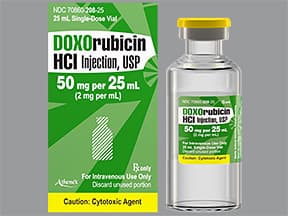
doxorubicin 50 mg/25 mL intravenous solution
Color: red-orangeShape: Imprint:This medicine is a red-orange, clear, vial

doxorubicin 2 mg/mL intravenous solution
Color: red-orangeShape: Imprint:This medicine is a red-orange, clear, vial
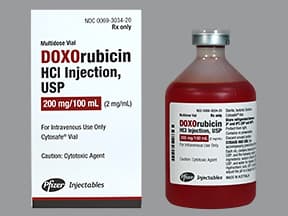
doxorubicin 2 mg/mL intravenous solution
Color: redShape: Imprint:This medicine is a red-orange, clear, vial
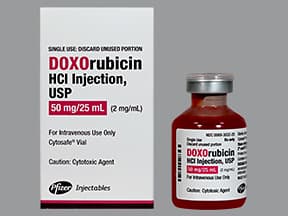
doxorubicin 50 mg/25 mL intravenous solution
Color: redShape: Imprint:This medicine is a red-orange, clear, vial
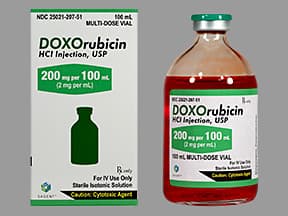
doxorubicin 2 mg/mL intravenous solution
Color: redShape: Imprint:This medicine is a red-orange, clear, vial
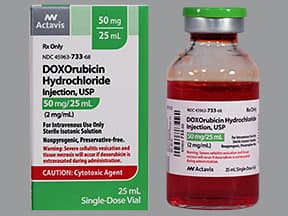
doxorubicin 50 mg/25 mL intravenous solution
Color: redShape: Imprint:This medicine is a red-orange, clear, vial
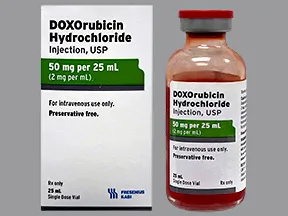
doxorubicin 50 mg/25 mL intravenous solution
Color: red-orangeShape: Imprint:This medicine is a red-orange, clear, vial
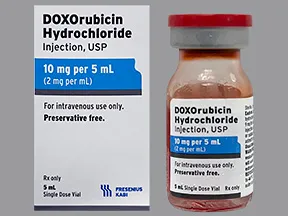
doxorubicin 10 mg/5 mL intravenous solution
Color: red-orangeShape: Imprint:This medicine is a red-orange, clear, vial
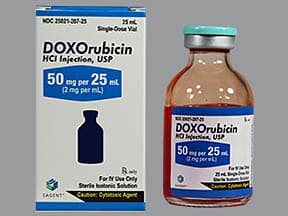
doxorubicin 50 mg/25 mL intravenous solution
Color: redShape: Imprint:This medicine is a red-orange, clear, vial
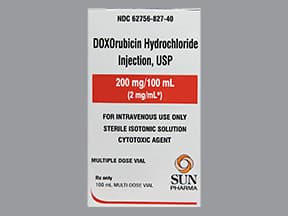
doxorubicin 2 mg/mL intravenous solution
Color: Shape: Imprint:This medicine is a red-orange, clear, vial
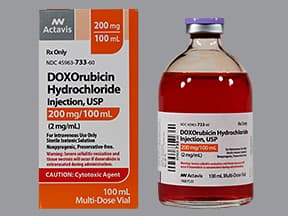
doxorubicin 2 mg/mL intravenous solution
Color: redShape: Imprint:This medicine is a red-orange, clear, vial
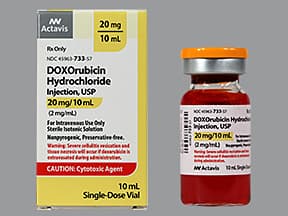
doxorubicin 20 mg/10 mL intravenous solution
Color: redShape: Imprint:This medicine is a red-orange, clear, vial
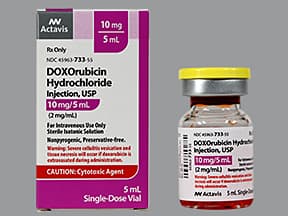
doxorubicin 10 mg/5 mL intravenous solution
Color: redShape: Imprint:This medicine is a red-orange, clear, vial
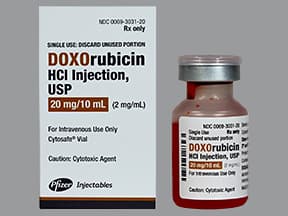
doxorubicin 20 mg/10 mL intravenous solution
Color: redShape: Imprint:This medicine is a red-orange, clear, vial
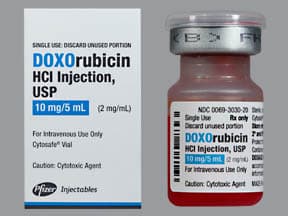
doxorubicin 10 mg/5 mL intravenous solution
Color: red-orangeShape: Imprint:This medicine is a red-orange, clear, vial
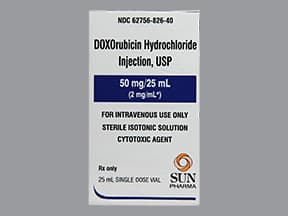
doxorubicin 50 mg/25 mL intravenous solution
Color: Shape: Imprint:This medicine is a red-orange, clear, vial
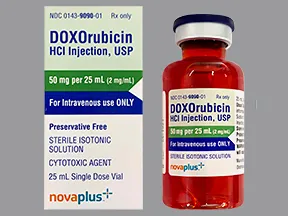
doxorubicin 50 mg/25 mL intravenous solution
Color: red-orangeShape: Imprint:This medicine is a red-orange, clear, vial
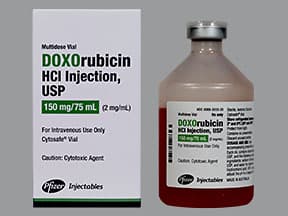
doxorubicin 2 mg/mL intravenous solution
Color: redShape: Imprint:This medicine is a red-orange, clear, vial
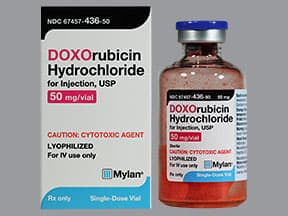
doxorubicin 50 mg intravenous solution
Color: red-orangeShape: Imprint:This medicine is a red-orange, clear, vial
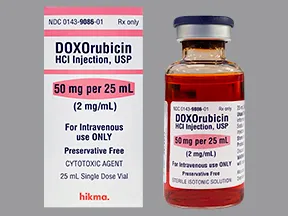
doxorubicin 50 mg/25 mL intravenous solution
Color: red-orangeShape: Imprint:This medicine is a red-orange, clear, vial
You Might Also Like
Are you currently using Doxorubicin HCL Vial?
This survey is being conducted by the WebMD marketing sciences department.
Selected from data included with permission and copyrighted by First Databank, Inc. This copyrighted material has been downloaded from a licensed data provider and is not for distribution, except as may be authorized by the applicable terms of use.
CONDITIONS OF USE: The information in this database is intended to supplement, not substitute for, the expertise and judgment of healthcare professionals. The information is not intended to cover all possible uses, directions, precautions, drug interactions or adverse effects, nor should it be construed to indicate that use of a particular drug is safe, appropriate or effective for you or anyone else. A healthcare professional should be consulted before taking any drug, changing any diet or commencing or discontinuing any course of treatment.